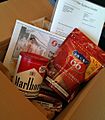Bias facts for kids
Bias means having a strong preference for one idea or thing over others. It's like having a favorite team and always thinking they are the best. This can make it hard to be fair to different ideas or groups.
Many things can cause bias. For example, a newspaper might favor a certain political party because many of its writers share those beliefs. This can make their articles show only one side of a story.
When an article or news report is biased, it only shares facts and quotes that support its main idea. It leaves out any information that might go against that idea. Imagine an article about motorcycles. If it's biased for motorcycles, it will talk about how fun they are and how little gas they use. If it's biased against them, it will focus on risks and noise, ignoring the good parts.
Bias can also show up in the words people use. Calling women "broads" or motorcycles "murdercycles" shows a negative bias. Making big assumptions about groups of people, like "All Chinese people are good at math," is also a sign of bias. These kinds of statements are unfair and untrue.
Bias can also happen in measurements. For example, if you measure someone's height while they are wearing shoes, the shoes add extra height. If you don't explain that the person was wearing shoes, the measurement would be biased. It would make them seem taller than they really are without shoes. When data has hidden extra parts like this, it's called biased data.
Contents
Understanding Bias
Bias is a common part of life. Everyone has some biases, even if they don't realize it. It's important to learn how to spot bias. This helps you think critically about information.
How Bias Affects Information
Bias can change how we see the world. It can make us believe things that are not fully true. When you read or watch the news, try to think about who made it. What might their biases be?
- News sources: Some news channels or websites might lean towards certain political views.
- Advertisements: Ads are biased to make you want to buy a product. They only show the good things.
- Social media: People often share opinions that match their own beliefs. This can create an "echo chamber" where you only see one side.
Types of Bias
There are many kinds of bias. Here are a few examples:
Confirmation Bias
This is when you look for information that proves what you already believe. You might ignore facts that go against your ideas. For example, if you think a certain video game is the best, you might only read reviews that praise it. You might skip reviews that say it's not so good. This makes you feel more certain about your original belief.
Sampling Bias
This happens when you collect information from a group that doesn't truly represent everyone. Imagine you want to know what all students in your school think about a new rule. If you only ask your friends, your results will be biased. Your friends' opinions might not be the same as everyone else's. To avoid this, you need to ask a wide variety of students.
Cultural Bias
This bias comes from your background and culture. What seems normal or right to you might be different for someone from another culture. For example, some gestures or customs mean different things in different parts of the world. Judging others based on your own cultural norms is a form of cultural bias.
Why Spotting Bias Matters
Learning to spot bias is a very useful skill. It helps you make better decisions. It also helps you understand different points of view.
- Making informed choices: When you know about bias, you can look for balanced information. This helps you decide what to believe.
- Understanding others: Recognizing that everyone has biases helps you be more understanding. It can reduce arguments and improve communication.
- Being fair: When you are aware of your own biases, you can try to be more fair. This is important in school, with friends, and in any group activity.
Being aware of bias helps you become a more critical thinker. It allows you to question information and form your own opinions based on facts, not just preferences.
Images for kids
-
When you collect a sample for a survey, it should be random. This helps make sure the sample truly represents the whole group.
See also
 In Spanish: Sesgo para niños
In Spanish: Sesgo para niños





